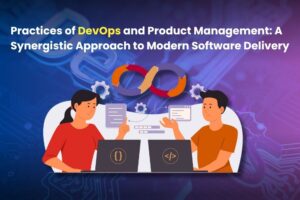In today’s fast-paced digital landscape, organizations must adopt efficient and reliable methods to deliver software. One of the most popular approaches for streamlining procedures, encouraging teamwork, and boosting creativity is DevOps, a collection of techniques that blends software development (Dev) with IT operations (Ops). However, implementing DevOps in a meaningful way requires more than just a change in tools—it calls for a cultural shift that encompasses people, practices, and technology. This article provides a five-point checklist designed to serve as a practical guide for executing DevOps successfully.
1. Establish a Collaborative Culture
- Embrace Cross-Functional Teams
Cultivating a culture that encourages cooperation amongst historically divided teams is essential to effective DevOps. Development, operations, quality assurance, and security must work cohesively as one unit. To achieve this, companies should establish cross-functional teams that share a unified set of goals and responsibilities. When team members understand each other’s roles and challenges, they are better positioned to innovate and respond quickly to issues, reducing bottlenecks in the development pipeline.
Promote transparency and open communication through daily stand-ups, regular retrospectives, and cross-team workshops. This approach not only enhances trust among teams but also accelerates issue resolution by encouraging diverse perspectives to contribute to problem-solving.
- Foster a Learning Environment
A vital aspect of a collaborative culture is the continuous learning mindset. This means investing in training, certifications, and regular knowledge-sharing sessions. Organizations should encourage team members to attend seminars, workshops, or online courses that focus on emerging DevOps practices and tools. Furthermore, nurturing an environment where experimentation is rewarded—even when failures occur—fosters innovation and continuous improvement.
Implement mentoring programs where senior team members can coach newer employees on DevOps methodologies. This fosters a culture of ongoing learning and development in addition to easing the learning curve.
- Align Incentives and Goals
The successful adoption of DevOps is dependent on aligning incentives across teams. Incentivize behaviors that drive collaboration, quality outcomes, and innovation. For example, bonuses, recognition programs, or performance reviews should focus on team achievements over individual victories. By ensuring that all participants in the development process are working toward the same corporate goals, aligning these incentives helps to minimize the conflict that frequently results from conflicting agendas.
DevOps Training in Pune provides a great environment to upskill these valuable skills.
2. Invest in Automation
- Streamline Repetitive Tasks
Automation is the engine that drives efficiency in a DevOps environment. Modern apps are becoming more sophisticated, and manual operations can cause errors and delays. Automating routine and repetitive tasks—such as code integration, testing, and deployment—helps ensure consistency and speed in delivering value to customers.
Automation is based on pipelines for continuous integration (CI) and continuous deployment (CD). They make it possible for developers to regularly integrate code changes, which initiates testing and deployments automatically. Organizations may lower the possibility of human mistakes and give teams more time to concentrate on higher-value work by automating these processes.
- Integrate Testing and Quality Assurance
Automating testing is crucial for maintaining high quality while ensuring rapid releases. The CI/CD pipeline should include end-to-end, integration, and unit tests. By simulating different user situations, automated testing frameworks may make sure that new code modifications don’t bring unanticipated defects or performance concerns.
Moreover, automated testing should not be confined to just validating functionality. Incorporate automated security scans and compliance checks to ensure that every release adheres to industry standards and internal policies. This integration of quality assurance into the automation framework is instrumental in maintaining robust and secure software delivery.
- Leverage Infrastructure as Code (IaC)
Another essential component of DevOps automation is Infrastructure as Code. Instead of using a physical hardware setup, IaC allows system administrators to manage and provision computing infrastructure via machine-readable specification files. This approach improves consistency across environments—from development to production—and mitigates the risks associated with manual configuration.
By adopting tools like Terraform, Ansible, or Chef, teams can create a reproducible environment that is both scalable and secure. Automating infrastructure provisioning also plays a significant role in disaster recovery and system resilience, as configurations can be easily version-controlled and audited.
3. Implement Continuous Integration and Continuous Delivery (CI/CD)
- Foster Rapid Feedback Loops
At its core, CI/CD is about establishing rapid feedback loops that bring code changes into production quickly and reliably. Code updates are regularly merged into a common repository as part of continuous integration, and each change is then verified by automated testing. This practice ensures that issues are caught early in the development cycle, significantly reducing the amount of time and resources needed for bug fixes.
Continuous delivery takes this approach a step further by automating the release process up to the production environment, ensuring that the software is always in a deployable state. This integration of continuous feedback loops not only improves the quality of the software but also empowers teams to react swiftly to market changes and customer needs.
- Emphasize Incremental and Frequent Deployments
Large, infrequent releases can lead to significant challenges, including complex regression issues and difficulties in pinpointing the source of problems. Instead, embrace an incremental deployment strategy where small, manageable updates are pushed continuously. This strategy reduces risk and enables businesses to swiftly iterate in response to consumer input.
It is essential to establish metrics and monitoring dashboards that track key performance indicators (KPIs) related to the deployment pipeline. Teams may assess the efficacy of their CI/CD pipeline and pinpoint areas for improvement with the use of metrics like lead time, deployment frequency, and mean time to recovery (MTTR).
- Integrate Security into the Pipeline
The rising significance of incorporating security into each stage of the CI/CD pipeline is reflected in the phrase “DevSecOps.” Security checks should be embedded within the automated process to identify vulnerabilities as early as possible. Organizations may guarantee that security is not an afterthought but rather an essential component of the software development lifecycle by integrating static and dynamic code inspection tools into the pipeline.
Incorporate regular security audits and vulnerability assessments. Not only does this practice help in mitigating risks, but it also instills a culture where everyone is accountable for maintaining a secure software environment.
4. Embrace Monitoring and Continuous Feedback
- Real-Time Monitoring and Analytics
One of the pillars of a successful DevOps strategy is the effective monitoring of both infrastructure and applications in real time. Leveraging sophisticated monitoring tools helps teams gain insights into performance bottlenecks, errors, and resource utilization. Tools such as Prometheus, Grafana, or Splunk provide comprehensive dashboards that track various metrics, enabling proactive problem detection and resolution.
Real-time monitoring supports not only operational efficiency but also aids in capacity planning and performance optimization. Making well-informed judgments that can improve system dependability and user happiness requires access to this constant flow of data.
- Establish a Feedback-Driven Culture
Beyond technological monitoring, continuous feedback from all stakeholders—including developers, operations staff, and end users—is indispensable. Feedback mechanisms such as surveys, user testing sessions, and direct communication channels help refine the product and address user needs more accurately. A feedback-driven culture encourages iterative improvements in both the software and the processes used to build it.
Regularly scheduled retrospectives are a key component of this feedback loop. They establish a forum for team members to talk on what worked, what could have been better, and how to make next releases better. To evolve procedures in line with the objectives of the company, this continuous process of reflection and adaptation is essential.
- Leverage Advanced Analytics and Reporting
Integrating advanced analytics into the monitoring process elevates the ability to predict and preempt performance issues. Utilize data analytics tools to conduct trend analysis, anomaly detection, and predictive maintenance. By analyzing historical data and patterns, teams can forecast potential failures or performance degradations and act before they impact end users.
Automated reporting systems may compile important KPIs, which helps leadership make well-informed decisions. Regular performance reviews based on these reports enable continuous process improvement, aligning the technical execution with strategic business objectives.
5. Optimize Toolchain Integration
- Develop a Unified Toolchain
A highly effective DevOps implementation depends on a well-integrated toolchain that spans the entire software development lifecycle. Organizations should conduct a thorough assessment of available tools to identify those that best fit their specific workflows and requirements. Transitions from coding and building to testing, deployment, and monitoring should be seamless with the right toolchain.
Key areas to consider when selecting a toolchain include compatibility, scalability, and the ease with which tools can be integrated. Open APIs, plug-in ecosystems, and active community support are factors that can significantly enhance the flexibility and longevity of your toolchain. The procedure is more effective and less likely to contain human mistakes when many tools function together harmoniously.
- Ensure Standardization and Governance
While having a broad set of tools is beneficial, it is equally important to standardize processes across teams. Establish clear governance models that define how tools are selected, implemented, and maintained. Standard operating procedures (SOPs) should outline best practices for using each tool in the chain, ensuring that everyone follows the same procedures and configurations.
By standardizing the tools and workflows, organizations can mitigate the risk of “tool sprawl,” where disparate systems hinder rather than help the development process. In addition to streamlining operations, this governance makes upcoming integrations and updates easier. Furthermore, standardized toolsets enhance cross-team collaboration, as members are more likely to be familiar with commonly adopted platforms.
- Invest in Continuous Improvement of the Toolchain
Your DevOps toolchain should be updated to reflect the ongoing growth of technology. An effective strategy is to adopt a continuous improvement mindset toward tooling. Schedule regular evaluations of the toolchain to identify outdated tools or those that are no longer aligned with the organizational goals. Encourage teams to provide feedback on tool performance and usability, and be willing to replace or upgrade tools as needed.
Investing in training on new tools and methodologies further ensures that the team remains at the cutting edge of DevOps practices. A well-maintained toolchain not only enhances operational efficiency but also empowers teams to innovate freely.
Conclusion
The journey to achieving a successful DevOps implementation is multifaceted, demanding deliberate changes across technology, processes, and team dynamics. This five-point checklist—focusing on establishing a collaborative culture, investing in automation, implementing robust CI/CD pipelines, embracing continuous monitoring and feedback, and optimizing toolchain integration—serves as a comprehensive roadmap for organizations looking to thrive in today’s competitive environment.
By fostering a culture that values collaboration and continuous learning, organizations create a foundation where cross-functional teams work in unison to overcome challenges. Reliability and efficiency in software delivery are guaranteed by automation and CI/CD processes, which shorten time-to-market while upholding strict security and quality requirements. Real-time monitoring and analytics provide critical insights into system performance and user experiences, paving the way for data-driven improvements. Lastly, in addition to streamlining the development process, a well-integrated and standardized toolchain enables teams to continually adapt to new problems and evolve.
Adopting these five strategic points does not guarantee overnight success, but it does equip organizations with the essential principles necessary for sustained growth and innovation. DevOps is not merely a set of practices, but a transformational journey that revolutionizes how software is built, tested, and deployed. It demands commitment from every level of the organization—from top executives setting the vision to individual team members executing daily tasks. When implemented successfully, DevOps can lead to faster delivery of robust, secure applications, improved operational performance, and ultimately, increased customer satisfaction.
By following this checklist and remaining adaptable to evolving best practices, you will set the stage for a successful DevOps journey that not only meets today’s challenges but also positions your organization to excel in the future.






